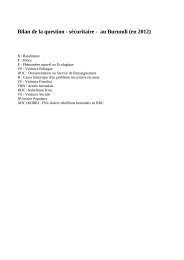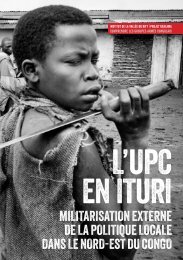Q3 Q4
g8iBkai
g8iBkai
Create successful ePaper yourself
Turn your PDF publications into a flip-book with our unique Google optimized e-Paper software.
!<br />
!<br />
!<br />
fran ·· q2 2016<br />
Figure 1. Main secondary movements in Europe according to the four entry<br />
routes defined<br />
Secondary movements<br />
from main entry routes:<br />
Western<br />
Eastern<br />
South-Eastern<br />
Southern<br />
Important flight routes<br />
Transport hub<br />
Madrid<br />
!<br />
!P<br />
!<br />
e<br />
£<br />
!<br />
!<br />
London<br />
!<br />
!P<br />
!<br />
Calais<br />
!P<br />
Paris<br />
!<br />
!<br />
!P<br />
lated to migrants who had arrived along<br />
the Central Mediterranean route.<br />
There have been several reports of facilitation<br />
cases of smuggling migrants across<br />
the Italian-French border in private cars<br />
for a fee. Local media informed that since<br />
the French authorities resumed systematic<br />
control at their national border with<br />
Italy on 15 May 2016, several facilitators<br />
have been arrested and convicted for migrant<br />
smuggling. 3 The fees are reported 4<br />
to be around EUR 150 per passenger. In<br />
August, the Italian authorities started to<br />
transfer, by bus, 400 migrants stranded<br />
near the French border in Ventimiglia to<br />
the Identification and Expulsion Centre in<br />
the Italian city of Tarente. 5<br />
3 http://www.nicematin.com/justice/<br />
nice-quatre-passeurs-de-migrantsincarceres-46504<br />
4 http://www.nicematin.com/faits-divers/<br />
ces-migrants-abandonnes-sur-les-bandesdarret-durgence-de-lautoroute-a8-55646<br />
5 http://www.nicematin.com/faits-divers/<br />
migrants-a-vintimille-les-autoritesitaliennes-haussent-le-ton-70572<br />
!<br />
!<br />
!<br />
!P<br />
!<br />
!<br />
!<br />
!P<br />
Barcelona<br />
!<br />
!P<br />
!<br />
!<br />
!<br />
Brussels<br />
Hamburg<br />
!<br />
!P<br />
!<br />
!<br />
!<br />
!P<br />
!<br />
!P<br />
Frankfurt<br />
Munich<br />
!P<br />
Milan<br />
Oslo<br />
Copenhagen<br />
!<br />
!P<br />
!<br />
Rome<br />
!P<br />
!<br />
!P<br />
!<br />
!<br />
!<br />
Passau<br />
!<br />
!<br />
!<br />
!P<br />
!<br />
!<br />
!<br />
!P<br />
!<br />
Vienna<br />
£<br />
!<br />
!P<br />
!<br />
Stockholm<br />
!<br />
!P<br />
£<br />
!<br />
!P<br />
!<br />
!<br />
!<br />
!<br />
!<br />
e<br />
!<br />
Warsaw<br />
Budapest<br />
!<br />
!<br />
e<br />
Helsinki<br />
!<br />
!P<br />
!<br />
£<br />
!P<br />
South-eastern route: Reported<br />
attempts to bypass Austria<br />
!<br />
Athens<br />
!<br />
Source: Frontex Risk Analysis Unit 2016<br />
The decision of the authorities of the<br />
countries along the Western Balkan route<br />
to close their borders for the irregular<br />
migrants who have arrived via the Eastern<br />
Mediterranean route and to gradually<br />
withdraw the organised transport through<br />
their territories made it more difficult to<br />
monitor irregular migration within Europe.<br />
In contrast, the large migratory flows of<br />
the late summer and autumn of 2015 were<br />
channelled on one main route, thus the<br />
migrants’ movements were more visible<br />
and quantifiable.<br />
In fact, the current level of intra-Schengen<br />
migration of persons coming on the Eastern<br />
Mediterranean and Western Balkan<br />
route is far lower than in 2015 and secondary<br />
routes became slightly more diverse.<br />
During the second quarter of 2016, Hungary<br />
reported a daily average of about 120<br />
illegal border-crossings from Serbia, which<br />
is a significant decrease from the around<br />
5 000 migrants that transited the West-<br />
Situation in Calais<br />
By the end of the summer the number<br />
of migrants staying in Calais and<br />
surrounding camps was estimated<br />
at around 12 000. At the end of September<br />
the French president, François<br />
Hollande, announced that the camp’s<br />
dismantlement would take place in the<br />
following month. The French authorities<br />
had also previously announced the<br />
construction of a wall to stop the migrants<br />
from disrupting the traffic and<br />
hiding in the lorries heading towards<br />
the UK. The construction of this barrier<br />
indeed started on 20 September. The<br />
dismantlement of the camp started at<br />
the end of October, while work on the<br />
wall was still ongoing. On 4 November,<br />
the French Minister of Interior,<br />
Bernard Cazeneuve, announced the<br />
camp had been fully dismantled. According<br />
to media reports, 5 132 adults<br />
and 1 932 minors were redistributed to<br />
reception centres all over the French<br />
territory. The minister also stated that<br />
since 17 October, 274 unaccompanied<br />
minors had been transferred to the<br />
UK. At the same time, 3 800 migrants<br />
were also placed in reception centres<br />
in Île-de-France region.<br />
Source: www.lemonde.fr, 4 November 2016<br />
Figure 2. The Gendarmerie performing<br />
checks at the French-Belgian<br />
border. The French authorities have<br />
extended the control at ‘authorised<br />
crossing points’ after the November<br />
2015 terrorist attacks in Paris. Since<br />
then, these controls have been<br />
reinforced several times, following<br />
international events such as the<br />
COP21 and the UEFA EURO 2016 and<br />
also after the terrorist attacks in<br />
Brussels in March 2016<br />
© nord.gouv.fr<br />
17 of 37






